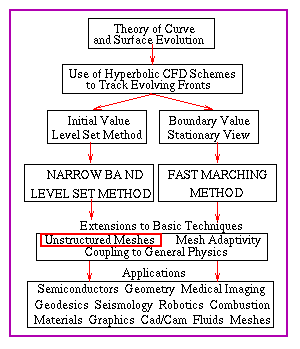Abstract
In the previous article, we discussed level set
and Fast Marching Methods on Cartesian meshes. In this paper, we review
the extension of much
of the methodology to triangulated domains; in particular, we discuss a
collection of schemes for solving general Hamilton-Jacobi and
level set equations in a triangulated and finite element framework.
The first scheme
is a provably monotone discretization for certain forms of the H-J
equations. While this basic scheme lacks proper
Lipschitz continuity of the numerical Hamiltonian, it can
be restored on acute triangulations through a ``virtual'' edge
flipping technique.
Next, schemes are presented based on the weaker concept
of positive coefficient approximations for homogeneous Hamiltonians.
These schemes possess a discrete maximum principle on arbitrary
triangulations and naturally exhibit proper Lipschitz continuity
of the numerical Hamiltonian.
These schemes are followed by a Petrov-Galerkin scheme from a
traditional finite element setting.
We also discuss the
addition and numerical approximation of a mean
curvature term. Finally, we review
several forms of mesh adaptation, and present some
numerical examples.
Complete details about triangulated Hamilton-Jacobi solvers
may be found in the article by Barth and Sethian.
In this paper, we discuss extensions to the basic method. We
present higher order versions of these techniques for both Cartesian
and unstructured meshes in both two and three space dimensions.
We cast the method in a general framework, and provide accuracy
tests and new applications of the underlying techniques.
Download publications

